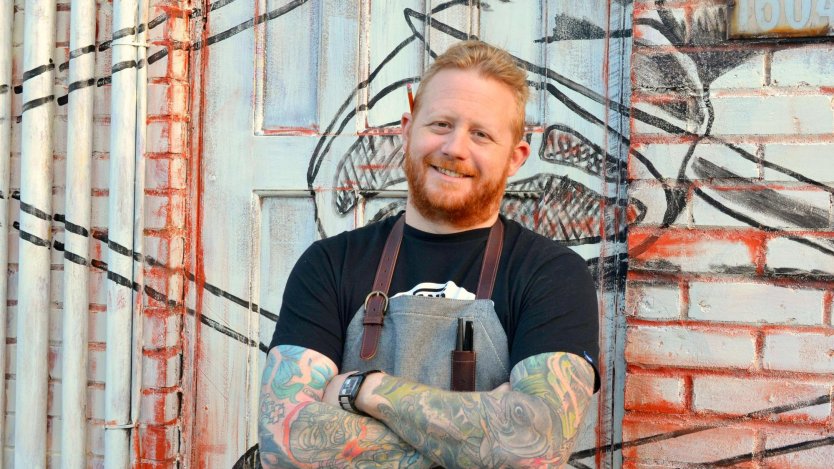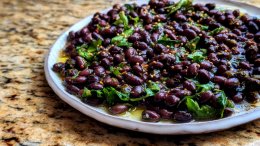"Ah, mon français est terrible!" I manage to spit out when the bartender of Maison Publique ask my friend and I what we would to drink.
"Pardon?"
"Pourriez-vous parler en anglais, sil vous plait?" I mumble out again apologetically, thus (likely said incorrectly) marking the end of my extent of conversational French.
"Yes. Drinks?"
Yes, after a mildly embarrassing start to our dining experience, we settle into a couple of spare seats at the bar. Cocktails were definitely in order.
Though my ego was slightly bruised from that exchange, the inviting and cozy feel of Maison Publique helped me get over it instantly. Located in the Plateau Mont-Royal area of Montreal, this quaint little spot is just as unassuming from the outside: dark corner door (which I've always been told is "bad chi", but is ubiquitous in Montreal) is set against a bright brick wall, with a glowing orange lamp hanging above. It's the kind of door you'd find in a Harry Potter movie in that town outside of Hogwarts. (Actually, on a cold night like this, a butter beer would have really been nice.)
Like most fairy tales, the beginning of Derek Dammann's journey to becoming the owner and chef of Maison Publique did not go smoothly. Back in the early 2000s, he decided to jet off to London from Vancouver Island, where he grew up, to explore the Eurpoean culinary scene. As a young chef, there were likely (Michelin) stars in his wide eyes as he touched down in the United Kingdom.
"My idea was to go over there, work, learn and travel," Dammann explains. "My first job was one of those work-in-the-pub-and-live-upstairs situations. It was a fucking shithole. I left after three days, right in the middle of lunch service. It’s the only job I’ve ever walked away from. Everything was rotting in the fridge. The other chef that was there was hammered from the time he woke up to when he passed out! I totally just bounced."
The chef continues: "Then I travelled a little bit around England, saw I was starting to run out of money and thought, 'Screw it! I’m going to just spend all of my cash and go home.' I changed my plane ticket and was set to go."
While spending the last of his savings before flying home to Canada, Dammann tried to grab a lunch at Fifteen, a new buzzworthy London eatery owned by celebrity chef Jamie Oliver at the time.
"I went in and it was full, so I couldn’t get in for lunch. I was sitting upstairs having a coffee and the hostess said there was a cancellation. So, I went down and ate and then I ended up talking," says Dammann. "Somebody asked if I was a cook because they were looking for people. I said 'OK. I’d like to do a trial.' They asked when I can do it and I said, 'Well, as soon as I’m finished my lunch, I’ll come start,' and then that was it. I changed my flight back, found a place to live and stayed."
I've never spent any time in a London kitchen, but if Gordon Ramsey has shown us anything (all television is real, right?), it's that there's a lot of shouting, kicking garbage cans and throwing pans that takes place on a daily basis. What was different about Fifteen, though, was that the restaurant also served as a groundbreaking apprenticeship program for less fortunate youth, offering them an opportunity to work in a positive environment and to grow the experience into a full-time career in the kitchen.
“It was great. I mean, obviously, it was challenging, but rewarding as well. You learned a lot of ways of how to deal with people in a good manner," says Dammann. "A lot of the kids came from a good place, but some of them had definitely seen a bit more than what you or I have, you know? Being able to use discipline through positivity was a very useful tool, even now.”
An unusual learning experience, no doubt, but one that was obviously filtered into the chef's way of running his kitchen in Montreal. I watched throughout dinner service as Dammann floated in and out from behind the kitchen queue. Casual, but attentive, the staff seemed harmonious and relaxed. I'd say leading with the iron fist is best left for past generations.
"I’ve worked with yellers and screamers and stuff like that, and it’s effective, for sure. But, you look at it from another point of view: if somebody is yelling and screaming all day long, how can you take them seriously when they are mad?" says Dammann. "If you’re at work, 16 to 18 hours a day, do you really want to be yelling and screaming for all 18 of them? How can you be a normal person for six?"

The design of Maison Publique is woodsman home meets brew pub; that is as good a picture as I can paint. The space exudes that cozy, come-in-for-a-pint-and-watch-the-game sort of atmosphere that is characteristically London. The menu — posted (en français) on a large, red board in the centre of the dining room — changes often, depending on what's available regionally.
"I just wanted it to be very Northern England, you know? Actually we had Billy Bragg come in here," Dammann points out. "He sat at the end of the bar and said that it looked just like a bar in Northern England, and that it reminded him of where he grew up. 'You nailed it!' he said, which was a nice compliment!"
Well, if it's A-OK with Billy Bragg, it's certainly alright by me.
The building itself boasts a surprising amount of history, having been a dépanneur [corner shop] and the original building owner's home, as well as different restaurants throughout the decades. As the chef recounts the various faces of the space, he points out that his back dining room was once a small stable for horses until Expo '67 took place in Montreal when the mayor at the time banned livestock in urban areas. That bastard!
While Dammann doesn't have livestock next door, he is a firm believer in quality animal care. His most recent delivery? A 450-pound pig that they butchered in-house for a variety of dishes and charcuterie.
"Depends," Dammann says, laughing when I ask him how often he brings in whole animals for butchering. "Since our last one was 450 pounds, it’s going to take at least a couple of weeks before we get another one. It was huge, actually gigantic. It was gigantic!"
After the pig has been butchered for different applications, Dammann used the remaining trimmings to make a pork tartare feature. Usually only available for a few days, the dish happens to be gracing the menu while I was by for a bite. Naturally, I took to Instagram to share the food, which was met with some wide-eyed smiley faces and "gross" remarks.

"I saw your instagram comments," Dammann says. "For tartare, if you go chop up a battery pig from a township where they’re biting their tails off, they’re fighting and there are 300 of them in a room, well you know... So, imagine all of these pigs tripping all over each other, in their own shit; terrible conditions. Yeah, I probably wouldn’t eat pork tartare from them. But, we know where ours is coming from. We’ve been to the farm, we see how they’re raised. There’s so much love and care; the farm doesn't feed them one bad thing."
I have never had pork tartare before, nor have I ever seen it on a menu. But, that doesn't mean that it is a bad or "gross" thing. When you truly believe in the purity of the ingredients that are being used, those fears should melt away and give you a new culinary experience.
"You can go to any restaurant around Montreal and have steak tartare. Where the fuck do you think the steak is coming from? Likely, some feedlot, but everyone loves their beef tartare," Dammann points out. "So, when they hear about pork tartare, they’re like, 'Oh my God! That’s disgusting.' They just don’t know; it’s actually a very Germanic dish."
Dammann goes on to explain that this application of pork (read: tartare) is used regularly in sandwiches in Germany and even stuffed in casings in Italy and left to ferment before eating. He continues: "It's crazy and delicious. I mean, you’ve had it; it’s delicious. We don’t run it all of the time. When we get a pig, we run it for two days and then it’s done."
Though the chef chose never to go back to the West Coast, I did see some B.C. staples on the ever-evolving menu, including big, juicy mussels and Beach Angel oysters served in somewhat of a Rockefeller format, but less old-school.
"I have certain things that are near and dear to my heart from the West Coast that I like to incorporate when the time comes, like the Beach Angel oysters," says Dammann. "They’re delicious. If they're out here, I’d get them, but they not."

When it comes to how the food hits the table, Dammann likes the presentation to be unpretentious and comfortable.
"We bring the food when it’s ready, sort of like Chinatown-style. What annoyed me about [some high-end places] is that people get their dish and whether you’re a food blogger, a foodie, or not even really into food, you get your plate and you hover over it; you protect it," says Dammann. "People's body language closes up and they don’t say anything; they don’t talk. Maybe you’ll share a bite, but that’s about it."
He continues, "Whereas if you put something in the middle and it comes out as it’s ready, people's body language opens up. They start making eye contact. Maybe the volume goes up a bit, maybe they drink a little more, but they’re having a bit more fun because they can pick and share and have a good time. I really like that about the way we eat."
It's no small feat to be recognized in enRoute's yearly Best New Restaurants. Dammann and his team were awarded that accolade this fall, settling in at number seven in the top ten. So, how does the chef intend to balance diners' expectations with all the hype that comes along with the buzz?
"The idea is just to be welcoming. At the end of the day, we’re a neighbourhood restaurant. It’s an honour to be on the list, for sure, but we want to maintain that we’re a neighbourhood restaurant," says Dammann. "That’s it! Show people a good time and be welcoming. Come in, stay warm, have a drink, order some food — that’s sort of the idea."
(4720 Marquette, Montreal. Twitter: @maisonpublique)













